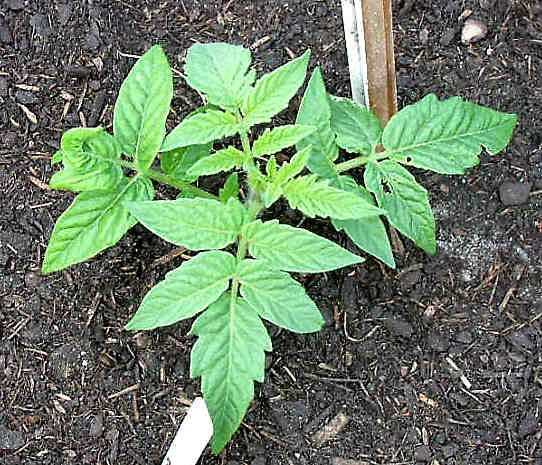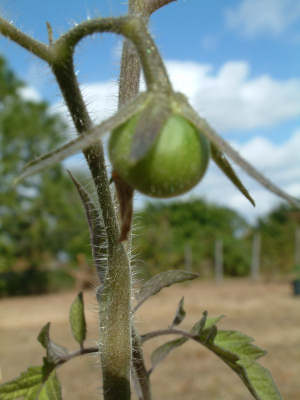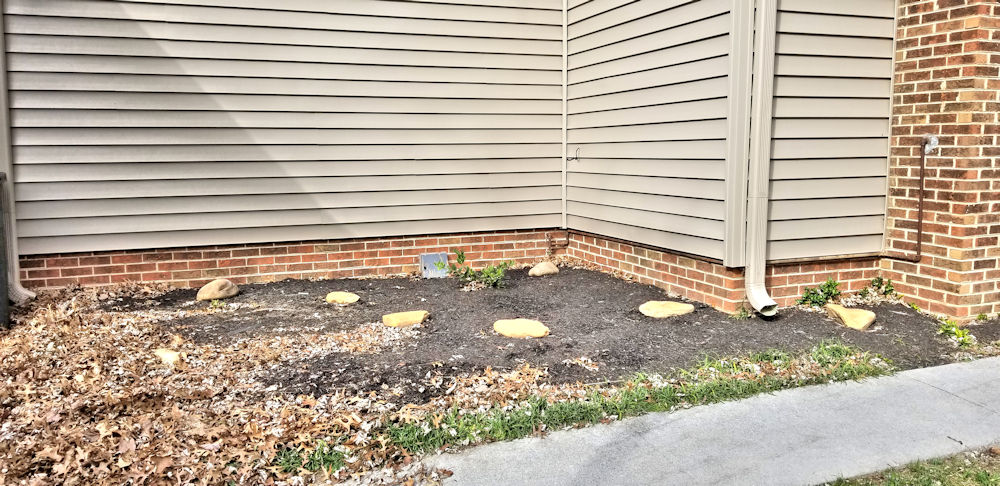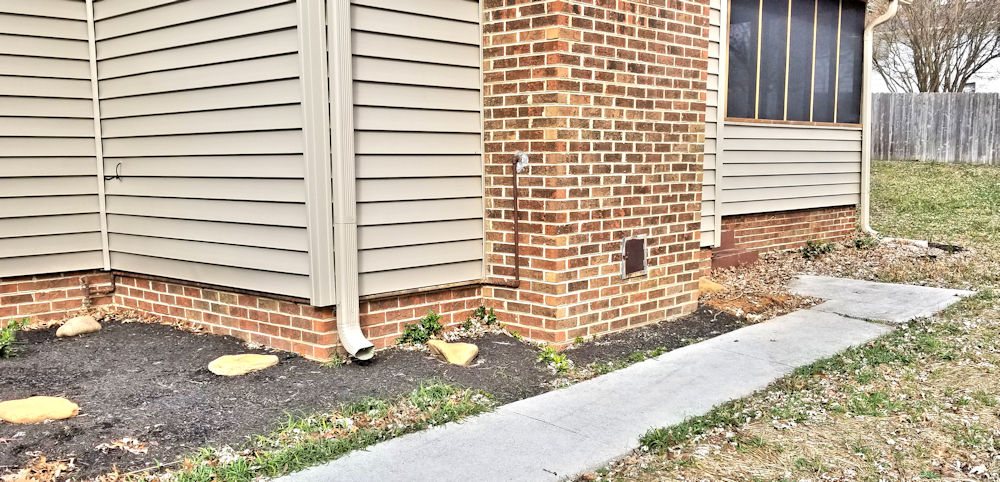Growing Tomatoes Indoors
Growing tomatoes indoors is something new I am trying out. Starting seeds indoors, sure, but actually growing the plants inside and harvesting the tomatoes? With my new location, it’s something I’m dying to try!
Tomatoes for Growing Indoors
I won’t be able to grow a full-sized tomato plant indoors, but I should be able to grow a mini tomato plant; something that is no more than about 12 inches tall. There are some where it’s claimed they can grow in a 4 inch container — but I want more tomatoes than something that small could give me. Some good tomato varieties that are in the 10 to 12 inch size range are Red Robin and Tiny Tim. Since I already have seeds for Red Robin, I think that’s what I’ll plant.
What’s Needed for Growing Tomatoes Indoors
Tomatoes need a place to live (a pot), light, water, soil and food (fertilizer).
- Light: Obviously, good light is necessary. While I do have a south-facing window, I don’t think it will be enough to support a good harvest. I’ll invest in some grow lights to supplement the light I do get.
- Pot/Container: My tomato plant needs a place to live, but I don’t have a ton of space. I’m going to go with a 1-gallon self-watering container (8 inch diameter).
- Water: Easy enough, especially with a self-watering container.
- Soil: I’ll need something that drains well, but also helps to hold moisture. In other words, I don’t want the water to just go through the pot before the roots can get the moisture — nor do I want the plants to have so much moisture that they have wet feet! A mix of potting soil, perlite and some sphagnum moss should give me what I need.
- Fertilizer: I think I can use the same fertilizer I use on my african violet and streptocarpus plants, which is a mixture of Miracle Gro for Orchids and Miracle Gro for Roses. I may be able to add some Sea Magic fertilizer, but because the plant will be indoors in closed room, fish emulsion is not an option. 😉 The fertilizer will be 1/2 strength, every other time I water.
What’s Missing?
Well, the tomato seedlings are missing! I’ve been itching to plant some tomato seeds, so this will be my chance to try out my new seed starting trays and heated seed germination mat.
Just for fun, I think I will also try to grow a Red Robin plant outside as well, and see what the difference is. Well, I’m sure it will grow better since it will be in a 3-gallon container, but the question is how much better?
Are Tomatoes Perennial?
Are tomatoes perennial? That’s a question a lot of people ask, so let’s talk about it in this post.
Annual Versus Perennial
First, let’s quickly review what perennial means, as well as what annual means, when it comes to plants.
- Annuals are those plants which live for a season. A season can be a couple of months, or perhaps up to 8 or so months. It refers to how long your growing season is, and what kind of weather your plants prefer.
- Perennials are plants which live for more than one season. If they appear to die due to (for example) frost or excessive heat, they will come back on their own once their preferred weather returns.
That’s a high-level difference between annual and perennial plants. Now let’s talk tomatoes.
Are Tomatoes Perennial?
Sadly, tomato plants are annuals. Now, that isn’t to say they can’t have a really long growing season, if they have the right environment. And if grown in a perfect environment (like a special greenhouse), it’s possible that some indeterminate tomatoes can last a year or more.
This applies more to cherry tomatoes, though, than tomatoes with larger fruits. Cherry tomato varieties are especially known for being vigorous growers and producing lots of fruits over a longer season.
Growing Indeterminate Tomato Plants as a Perennial
OK, so let’s say you have a pretty perfect environment. Not too hot, not too cold, humidity just right, plenty of sun. Plus, not exposed to tomato plant diseases and with few or no insects that love to munch on tomato plants. Oh, and plenty of room, because indeterminate tomato plants can get mighty big.
(Now you see the dilemma.)
It seems like the best environment would be a greenhouse or in an enclosed sunroom. Tomatoes like their warmth, but they don’t like high temperatures. And they don’t care for cool weather, at least not during the day. They do like moderate humidity, and good air circulation. Plus — 6 to 8 hours of direct sunshine per day, or the equivalent in bright grow lights.
If you can also control exposure to tomato diseases (many of which have to do with soil and wind-borne contaminants), and regularly patrol for tomato-loving insects, you’ve gone a long way to giving your tomato plant a longer life.
Now, let’s talk about the tomatoes themselves — because why grow the plants if you don’t plan to eat the tomatoes!
How Tomatoes Fruit on the Plant
Tomatoes set fruit starting with lower branches, and proceed upwards on the plant. Once a branch has set fruit, it’s not going to flower again once the fruit has been picked. And this means that your plant needs to grow taller in order to continue setting fruit. Alternately, it will need to bush out to continue fruiting.
If you plan to grow your tomato plants indoors under grow lights, they will need to have good light all over the plants as it grows taller and/or wider. This may mean multiple grow lights.
Growing Tomato Plants
By now you can tell that the answer to the question of “are tomatoes perennial” is that they are best grown as the annual that they are. If you plan to try to grow a tomato plant as a perennial, though, your best bet is with an indeterminate cherry tomato plant variety.
Homegrown Tomatoes Planned for 2020
What homegrown tomatoes are in store for me in 2020? As I mentioned in my previous post of my new location, I’ve got a whole different growing style to get used to.
Instead of two short growing seasons, I have one longer one. If I am lucky, I’ll be able to do a little succession planting. The humidity up here isn’t nearly as bad as S Florida, even though I still will get days in the 90s come August. My season starts in early April, so I’m lining up all my supplies now.
All that being said, what tomato varieties do I have planned for the 2020 gardening season? Here’s what I want to grow.
Tomato Varieties Planned for 2020
I’m going with all new (to me) varieties, with one exception. All are either heirloom or open-pollinated, so I can save seeds if I like. And for a change, I am planting some dwarf tomatoes! Here is the lineup:
- Dwarf Arctic Rose: Determinate, pink, early-season. Regular rugose leaves. Fruits average 2 to 5 ounces.
- BrandyFred: Indeterminate (dwarf), purple, mid-season. Potato rugose leaves. Fruits average around 10 ounces.
- Dwarf Pink Passion: Indeterminate, pink, mid-season. Regular rugose leaves. Fruits average 8 ounces.
- Dwarf Bendigo Blush: Indeterminate, pink, mid-season. Potato rugose leaves. Fruits average 1 to 2 ounces.
- Red Robin: Determinate, red, early-season. Regular rugose leaves. Fruits average 1 ounce. Not a dwarf so much as a tiny micro-determinate — tiny as in maybe 10 inches tall. This is the one variety I have grown in the past, so I’m looking forward to seeing how it grows up here.
- Tennessee Yellow Cherry: Indeterminate, yellow, early-season. Regular leaves. Fruits average 1 ounce per tomato – supposed to be very prolific. And since I now live in Tennessee, it seemed appropriate. 😉
- Vorlon: Indeterminate, purple, mid-season. Potato leaves. Fruits average 6 to 8 ounces. I get a kick out of the show “Babylon 5”, and this was supposedly named after a character on the show. I just couldn’t resist, and purple tomatoes are generally pretty flavorful.
Three unusual varieties I’ll be growing are:
- Blue Beauty: Indeterminate, blue, early- to mid-season. Regular leaves. Unknown average size. I’ve not grown a blue tomato as yet, so this will be my first. The “blue” is due to anthocyanin, which is more of an indigo-purple color.
- Alice’s Dream: Indeterminate, blue/striped, mid-season. Regular leaves. Unknown average size. I have to admit, this one intrigues me. More anthocyanin, so it’s a “blue” tomato, but ripens to what looks like a striped tomato. It’s supposed to be beautiful and tasty!
- Girl Girl’s Weird Thing: Indeterminate, striped red/green, mid- to late-season. Regular leaves. Unknown average size, but appear to be medium. The name drew me in, and the striped red and green was fascinating. Supposed to be very tasty.
Although Blue Beauty, Alice’s Dream and Girl Girl’s Weird Thing have unknown average sizes, from the photos I’ve seen I guess that between 6 and 10 ounces seems reasonable. I know that “tasty” can vary from person to person, so when I eventually review these varieties, I’ll have to compare them against some well-known varieties for comparison.
I’m really excited to be growing in this new location, and with these new-to-me tomato seeds. I look forward to sharing my progress and photos of the garden and tomatoes.
Homegrown Tomato Garden – New Decade, New Location
Happy New Year! My homegrown tomato garden is celebrating the new decade in a new location. I don’t live in S. Florida anymore — I am in eastern Tennessee. My normal growing pattern is topsy-turvey; no Winter planting, but I do get to grow through the summer.
I’ve gone from 10a for a plant hardiness zone to 7a. Which basically means a chilly winter with plenty of freezes, and a last expected frost date in mid-April. But interestingly so far, with all the frosts we’ve had so far this Fall and Winter, our yard doesn’t seem to collect frost; across the street does, though. Talk about being in a micro-climate!
Different State, Different Soil for the Tomatoes
I’m used to sandy soil, which is fairly easy to dig up. I had a lovely spot planned for the garden for my homegrown tomatoes; I was going to rototill it, put down plenty of compost. First, I decided to plant a few daffodil bulbs nearby. Imagine my surprise when instead of an easy to dig soil, I found compacted clay and rocky soil. Argh! (I barely got 10 bulbs planted before I gave up.)
There goes my plans for rototilling the garden. I’d have to put down so much compost and perlite that I’d be rototilling for weeks, and spend many hundreds of dollars. With those plans out the window, I’m turning to container gardening.
Container Tomato Garden For 2020
Fortunately, I’ve had a lot of experience with container gardening my tomatoes. The approximately 12 x 7 foot garden plot will be festooned with 3-gallon, 5-gallon, 7-gallon and 10-gallon grow bag containers. I have some room to expand a little to the northeast of that plot, maybe a little more across the walkway.
Right now it doesn’t look like much; well, it is the tag end of December. I still have to pull up one bush that is in my way, but I think it’s small enough to not give me too much trouble. But, it faces southeast and is protected by the house on 3 sides, giving it another micro-climate; I may be able to put out at least some of my plants a week or so before the last expected frost date.
Well, this should be interesting, to say the least! My growing situation is much different from where I gardened for some 20 years. I am very much looking forward to see what kind of homegrown tomatoes I can successfully garden here, and share the results with you. 😀
Soil for Container Gardening
You’ve decided to create a container garden of one or more containers, or are using raised beds. You have the containers/beds…but what do you fill them with? As I mentioned in my tomatoes in containers post, it’s time to talk soil.
Ready Made or Mix Your Own?
To be honest, I would rather go with pre-bagged, if I could find exactly what I wanted, in the amounts I needed, at a good price. Given that I am still trying to fill something along the lines of 15 containers from 5 to 25 gallons each, that doesn’t quite work out — for me or the plants. For that kind of quantity, quality bagged potting soil can be expensive. However, if you are just filling a couple of 5 gallon containers, bagged potting soil might be just right for you.
The most important thing for container plants is that the roots have enough water and air. In order for water and air to penetrate the soil, it needs little spaces to slip into.
As a somewhat exaggerated example, it’s almost impossible for air and water to penetrate much into concrete. However, water and air pass easily through gravel. (Although I don’t recommend trying to grow in either, LOL.) 😉
So what you are looking for is soil that has enough space for air and water, but not so much that water pours right though it. Just keep thinking about Goldilocks and getting the mixture “just right”. 😉
Potting Mix, Garden Soil – What’s the Difference?
A potting mix is made especially for growing plants in containers. A bag of garden soil, though, is made to be mixed in with your current soil — not just placed in your containers without any intervention.
A good potting mix is fluffy, with plenty of perlite or vermiculite and sphagnum peat moss or coconut coir (in addition to compost, of course). Garden soil tends to be heavy, with little or no perlite, vermiculite or moss/coir. Putting the bagged garden soil into your containers without lightening it up some will doom your plants to a slow death. Or at the very least, a much smaller harvest, because the plant roots have a hard time breathing.
What About “Mel’s Mix”?
Mel Bartholomew, of Square Food Gardening (SFG) fame, recommends the following mix. Although I don’t use the SFG method with the grid, etc., I do like the basics of his soil mix. It is:
- 1/3 Compost
- 1/3 Vermiculite
- 1/3 Peat Moss or Coconut Coir
The catch is that the compost needs to be from several sources. In other words, look at the ingredients that go into the compost you plan to use. If you’re not making the compost yourself (and maybe even if you are), you don’t want everything to be from one source.
For example, instead of buying 3 bags of compost that are all based on cow manure, you would want a bag of the cow manure-based compost, one of humus-based and another of poultry litter-based.
That being said, if you can’t find compost made from varying ingredients, try to at least get some from different manufacturers.
BTW, I do recommend reading Mel’s book, the All New Square Foot Gardening, Third Edition.
Other Ingredients?
Well, there are other “goodies” you can use to feed your soil, but that is a whole separate post. I’ll come back and put a link to that post when I have it completed. I am doing some experimenting, and so far the results have been quite interesting.
Mixing it Up
I typically mix my contain gardening soil up in a wheelbarrow — those 20 gallon pots really take a lot to fill them up! But sometimes, I only need to make up enough for a small planter.
For a small batch, I get one of those 5-gallon buckets (like you can get at Home Depot or Lowes) and scoop in a few trowels worth of compost. Next I’ll put in a trowel of vermiculite, another of perlite and then a scoop or two of coconut coir. I’ll mix that around with my trowel until it’s nice and blended, then pour it into its pot.
If the pot doesn’t end up being quite full enough, I’ll just throw in a handful or two of each of the above, then mix it all up by hand.
Compost is Your Plant’s Friend
I’d be remiss if I didn’t talk a little more about compost. If you have your own pile, you have ready access to it, and it’s probably full of all sorts of goodies for your tomato plants. If you don’t have a compost pile, you’ll need to go with a bagged compost.
When you walk down the aisles of your garden center, you’re likely to find several different brands of bagged compost. Take a look at the bags and read the ingredients. In Florida where I live, it’s heavy on the composted cow manure — believe it or not, we’re one of the top states for producing cattle (and you just thought we were beaches). What’s harder to find are composts from forest humus or mushroom compost. Read the labels, and if you can, get at least two different kinds. Each type is a little different with the (good) soil bacteria and/or (good) fungi, and so provides a more balanced set of nutrients.
Don’t make the mistake of thinking that all you need in your container is compost, though — it’s a bit too heavy (been there, done that). You will need to mix it with one or more of the perlite, vermiculite, etc. before planting your tomatoes in it.
For the few times I’ve planted in straight compost, the plants didn’t do so great. Yes, they grew and produced tomatoes but they seemed didn’t grow or produce as well as the containers where I had a mix.
Whew — that was a long post. Hopefully this has been helpful for you!


